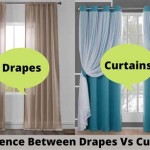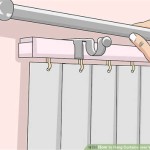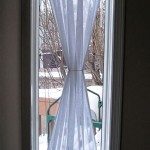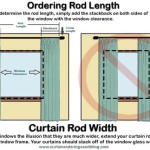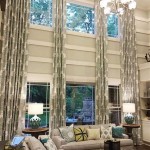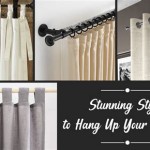Hanging Curtains Over Sliding Glass Doors: A Comprehensive Guide
Sliding glass doors offer numerous benefits, including abundant natural light and seamless access to outdoor spaces. However, they can also pose challenges in terms of privacy, light control, and energy efficiency. Hanging curtains over sliding glass doors is a practical and aesthetically pleasing solution to address these issues, offering a versatile way to enhance the functionality and comfort of a living space.
Selecting the right curtains and hardware is crucial for achieving the desired effect. Factors to consider include the size and style of the sliding glass door, the amount of light and privacy required, and the overall aesthetic of the room. Proper installation is equally important to ensure that the curtains function smoothly and look visually appealing. This article provides a detailed guide to hanging curtains over sliding glass doors, covering various aspects from curtain selection to installation techniques.
Choosing the Right Curtains for Sliding Glass Doors
The type of curtains selected for a sliding glass door significantly impacts the room's ambiance and functionality. Different fabrics, styles, and features offer varying degrees of light control, privacy, and insulation.
Fabric: The choice of fabric is a primary consideration. Lightweight fabrics like voile and sheer linen allow ample natural light to filter through while providing a degree of privacy. These are suitable for spaces where maximizing light is a priority. Medium-weight fabrics like cotton or linen blends offer a balance between light diffusion and privacy. They are versatile and suitable for a variety of spaces. Heavyweight fabrics like velvet or blackout materials offer maximum privacy and light blockage. These are ideal for bedrooms or home theaters where darkness is desired. Moreover, the fabric impacts the energy efficiency of the room. Heavier, insulated fabrics can help regulate temperature, reducing heat loss in winter and heat gain in summer.
Style: Different curtain styles offer distinct visual effects and functionality. Panel curtains are a classic choice, consisting of individual fabric panels hung from a rod. They are easy to install and offer versatility in terms of fabric and pattern selection. Grommet curtains feature metal rings at the top that slide onto the curtain rod. They create a clean, contemporary look and are easy to open and close. Pleated curtains have structured folds at the top, creating a more formal and tailored appearance. These require more precise installation and are often more expensive than panel or grommet curtains. Vertical blinds are another option, featuring vertical slats that can be rotated to control light and privacy. While not technically curtains, they serve a similar function and are often used for sliding glass doors. They offer a modern aesthetic and are easy to clean.
Length and Width: Accurate measurements are essential for selecting the right curtain size. The length of the curtains should be determined based on the desired aesthetic. Curtains can be floor-length, grazing the floor, or slightly puddling for a more dramatic effect. The width of the curtains should be at least twice the width of the sliding glass door to ensure adequate fullness and coverage when closed. This allows the curtains to drape gracefully and effectively block light and provide privacy.
Color and Pattern: The color and pattern of the curtains should complement the existing décor and create the desired mood. Light colors can brighten a room and make it feel more spacious, while dark colors can add warmth and drama. Patterns can add visual interest and personality to a space. Consider the existing color palette and patterns in the room when selecting curtains to ensure a cohesive and harmonious design. For minimalist spaces, solid-colored curtains might be preferable. For more eclectic spaces, patterned curtains can add a layer of complexity.
Selecting the Appropriate Hardware
The hardware used to hang curtains over a sliding glass door plays a crucial role in both functionality and aesthetics. The choice of rod, brackets, and other accessories should be carefully considered to ensure a secure and visually appealing installation.
Curtain Rods: Curtain rods are available in a variety of materials, styles, and diameters. Metal rods, such as steel or wrought iron, are durable and can support heavier fabrics. Wood rods offer a more traditional and warm aesthetic. The diameter of the rod should be chosen based on the weight of the curtains. Thicker rods are typically required for heavier fabrics to prevent sagging. The length of the rod should extend beyond the width of the sliding glass door to allow the curtains to be fully opened without obstructing the view or access to the door. Extending the rod on either side, typically 6-12 inches, allows the curtains to stack off the glass, maximizing light and view when the curtains are open. Also, consider a traverse rod specifically designed for sliding curtains. These rods have channels or tracks that allow the curtains to slide smoothly and easily.
Brackets: Brackets are used to support the curtain rod and should be securely mounted to the wall. The type and number of brackets needed will depend on the length and weight of the rod and curtains. Standard brackets are typically used for lighter curtains, while heavy-duty brackets are recommended for heavier fabrics. The brackets should be positioned at equal intervals along the rod to ensure even weight distribution. When installing brackets, ensure they are anchored into wall studs for maximum stability. If studs are not available, use appropriate drywall anchors to support the weight of the curtains and rod. The placement of the brackets affects the drop of the curtains. Higher placement will make the windows appear taller while lower placement will emphasize the width of the door.
Rings and Hooks: Rings and hooks are used to attach the curtains to the rod. The type of rings and hooks used will depend on the style of the curtains. Grommet curtains typically slide directly onto the rod, while pleated curtains require hooks that attach to the pleats. The rings and hooks should be made of a durable material that can withstand repeated use. Consider the finish of the rings and hooks to complement the overall aesthetic of the curtains and hardware. For example, metallic rings can add a modern touch while wooden rings can enhance a rustic feel. For traverse rods, specialized carriers are used to attach the curtains and allow them to slide along the track.
Tiebacks and Holdbacks: Tiebacks and holdbacks are used to hold the curtains open during the day. Tiebacks are fabric or rope straps that wrap around the curtains, while holdbacks are decorative hooks or brackets that are mounted to the wall. These accessories can add a decorative touch to the curtains and keep them neatly arranged when open. The placement of tiebacks and holdbacks should be carefully considered to ensure they are functional and visually appealing. Generally, they are placed about one-third of the way down from the top of the curtains.
Installation Techniques for Hanging Curtains
Proper installation is crucial for ensuring that the curtains function smoothly and look visually appealing. Accurate measurements, secure mounting, and attention to detail are essential for a successful installation.
Measuring and Marking: Before starting the installation, accurately measure the width and height of the sliding glass door and the surrounding wall space. Determine the desired length and width of the curtains and the placement of the rod and brackets. Use a level to ensure that the rod and brackets are installed straight and even. Mark the locations for the brackets on the wall using a pencil. Accurate measurements are critical to avoid mistakes that can lead to uneven or poorly fitting curtains. Measure twice, cut once, is a good principle to follow.
Mounting the Brackets: Use a drill to create pilot holes for the bracket screws. Ensure that the holes are deep enough to accommodate the screws. If mounting the brackets to drywall, use drywall anchors to provide additional support. Insert the anchors into the pilot holes and then attach the brackets using screws. If mounting the brackets to wall studs, use longer screws that can penetrate the stud for a secure hold. Ensure that the brackets are securely fastened to the wall before proceeding. The stability of the brackets is essential for supporting the weight of the curtains and rod.
Installing the Curtain Rod: Once the brackets are securely mounted, carefully place the curtain rod onto the brackets. Ensure that the rod is properly seated in the brackets and that it is level. If using a traverse rod, ensure that the carriers are properly installed and that the rod slides smoothly along the track. For adjustable rods, extend the rod to the desired length and tighten the locking mechanism. A properly installed curtain rod should be stable and able to support the weight of the curtains.
Hanging the Curtains: Attach the curtains to the rod using rings, hooks, or grommets, depending on the style of the curtains. Ensure that the curtains are evenly distributed along the rod and that they hang straight. Adjust the pleats or folds of the curtains as needed to create the desired visual effect. For traverse curtains, attach the curtain hooks or pins to the carriers on the traverse rod. Test the movement of the curtains to ensure they slide smoothly and easily. Adjust the placement of the rings, hooks, or grommets as needed to achieve a uniform and balanced appearance.
Adjusting and Finishing: After hanging the curtains, step back and assess the overall appearance. Adjust the length of the curtains as needed to ensure they are hanging at the desired height. Use tiebacks or holdbacks to hold the curtains open during the day. Trim any loose threads or imperfections. Ensure that the curtains are clean and wrinkle-free. A well-installed set of curtains should enhance the aesthetics of the room and provide the desired level of privacy and light control. Periodic adjustments and maintenance may be necessary to keep the curtains looking their best.

How To Hang Curtain Rod Over Sliding Door Patio Curtains Home Decor Window Treatments

Patio Door Coverings Sliding Glass Curtains Window

How To Hang Curtains Over Sliding Glass Doors Door Small Bedroom

A Ultimate Guide To Hanging Curtain Rod Over Sliding Glass Door Signaturethings

How To Hang Curtains On Sliding Glass Doors Sunparadise Monoslide

Curtains For Sliding Glass Doors Ideas Inspired Design

Are Curtains Or Blinds Better For Sliding Doors 2024 Guide

11 Best Sliding Door Blinds Ideas Coverings Window Treatments

12 Best Sliding Glass Door Curtains Ideas

What S The Best Curtain Rod For A Sliding Glass Door Design Morsels
See Also

